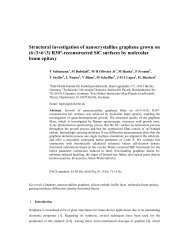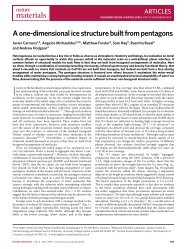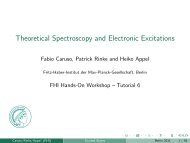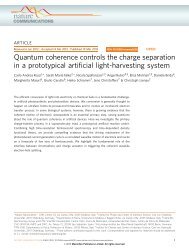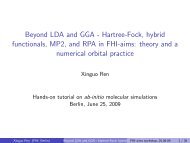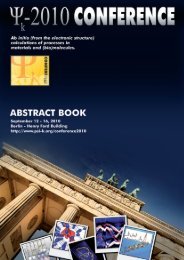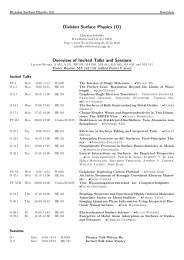present - Theory Department of the FHI
present - Theory Department of the FHI
present - Theory Department of the FHI
You also want an ePaper? Increase the reach of your titles
YUMPU automatically turns print PDFs into web optimized ePapers that Google loves.
Volker Blum<br />
State <strong>of</strong> <strong>FHI</strong>-aims<br />
Density Functional <strong>Theory</strong> and Beyond - Berlin, August 28, 2012
Objective: Electronic structure <strong>the</strong>ory today<br />
Enormous successes:
Objective: Electronic structure <strong>the</strong>ory today<br />
Enormous successes:<br />
(Bio)molecular matter<br />
• Structural complexity<br />
• statistical averages & dynamics<br />
• “weak” interactions critical
Objective: Electronic structure <strong>the</strong>ory today<br />
Enormous successes:<br />
(Bio)molecular matter<br />
• Structural complexity<br />
• statistical averages & dynamics<br />
• “weak” interactions critical<br />
Graphene / SiC<br />
Condensed phases<br />
(solids, surfaces, ...)<br />
• Structure!<br />
• Stability, free energies<br />
Ta3W3<br />
Ta4W9<br />
• electronic, mechanical, optical, ... properties
Objective: Electronic structure <strong>the</strong>ory today<br />
Enormous successes:<br />
(Bio)molecular matter<br />
• Structural complexity<br />
• statistical averages & dynamics<br />
• “weak” interactions critical<br />
Graphene / SiC<br />
Condensed phases<br />
(solids, surfaces, ...)<br />
• Structure!<br />
• Stability, free energies<br />
Ta3W3<br />
Ta4W9<br />
• electronic, mechanical, optical, ... properties<br />
Matter at extreme conditions<br />
• “electron gas + protons”; high-pressure compounds, transitions<br />
• (Born-Oppenheimer) molecular dynamics, classical nuclei<br />
• Quantum nuclei? (PIMD)
Objective: Electronic structure <strong>the</strong>ory today<br />
Enormous successes:<br />
(Bio)molecular matter<br />
• Structural complexity<br />
• statistical averages & dynamics<br />
• “weak” interactions critical<br />
Graphene / SiC<br />
Condensed phases<br />
(solids, surfaces, ...)<br />
• Structure!<br />
• Stability, free energies<br />
Ta3W3<br />
Ta4W9<br />
• electronic, mechanical, optical, ... properties<br />
Today: “Mostly density-functional <strong>the</strong>ory”, plenty <strong>of</strong> flavors<br />
Matter at extreme conditions<br />
• “electron gas + protons”; high-pressure compounds, transitions<br />
• (Born-Oppenheimer) molecular dynamics, classical nuclei<br />
• Quantum nuclei? (PIMD)
Electronic structure <strong>the</strong>ory for real materials<br />
... but also some significant challenges:
Electronic structure <strong>the</strong>ory for real materials<br />
... but also some significant challenges:<br />
• Are we computing <strong>the</strong> right thing?<br />
‣ Current DFT (LDA/GGA and beyond) may qualitatively fail with or without<br />
warning for much <strong>of</strong> <strong>the</strong> interesting space, even for “structure”<br />
‣ O<strong>the</strong>r numerical approximations? (grids, cut<strong>of</strong>fs, core vs. valence, ...)<br />
‣ “Classical” vs. “quantum” nuclei? Born-Oppenheimer?
Electronic structure <strong>the</strong>ory for real materials<br />
... but also some significant challenges:<br />
• Are we computing <strong>the</strong> right thing?<br />
‣ Current DFT (LDA/GGA and beyond) may qualitatively fail with or without<br />
warning for much <strong>of</strong> <strong>the</strong> interesting space, even for “structure”<br />
‣ O<strong>the</strong>r numerical approximations? (grids, cut<strong>of</strong>fs, core vs. valence, ...)<br />
‣ “Classical” vs. “quantum” nuclei? Born-Oppenheimer?<br />
• Can we compute <strong>the</strong> right thing?<br />
‣ Realistically sized systems to capture “reality”<br />
‣ Statistical averages, dynamics, combinatorial complexity <strong>of</strong> “structure”?<br />
‣ Simply, hardware vs. s<strong>of</strong>tware - utilize available hardware effectively
Outline<br />
‣ <strong>FHI</strong>-aims: Some (very) few basics<br />
‣ Significant new developments:<br />
Periodic Hartree-Fock and hybrid functionals<br />
Unit cell relaxation & analytical stress tensor<br />
Many-body perturbation <strong>the</strong>ory: scGW and rPT2<br />
“Quantum nuclei”<br />
... many o<strong>the</strong>rs! (transport, visualization, ...)<br />
‣ and how far can we push? Large-scale surface reconstruction<br />
‣ “What would be good to have” (future?)
People<br />
Fritz Haber Institute, Berlin [Richard-Willstätter-Haus]
People<br />
Matthias<br />
Scheffler<br />
Fritz Haber Institute, Berlin [Richard-Willstätter-Haus]
People<br />
Matthias<br />
Scheffler<br />
Karsten<br />
Reuter<br />
(now Munich)<br />
Fritz Haber Institute, Berlin [Richard-Willstätter-Haus]
People<br />
Matthias<br />
Scheffler<br />
Karsten<br />
Reuter<br />
(now Munich)<br />
Patrick<br />
Rinke<br />
Fritz Haber Institute, Berlin [Richard-Willstätter-Haus]
People<br />
Matthias<br />
Scheffler<br />
Karsten<br />
Reuter<br />
(now Munich)<br />
Patrick<br />
Rinke<br />
... <strong>FHI</strong>-aims - MANY contributors:<br />
Xinguo Ren, Ville Havu, Paula Havu, Ralf Gehrke,<br />
Rainer Johanni, Andreas Dolfen, Felix Hanke,<br />
Stefan Gutzeit, Andrea Sanfilippo, Luca<br />
Ghiringhelli, Mariana Rossi, Alex Tkatchenko,<br />
Sergey Levchenko, Matthias Gramzow, Benedikt<br />
Biedermann, Aloysius Soon, Mina Yoon, Jörg<br />
Meyer, Christian Carbogno, Norbert Nemec,<br />
Fabio Caruso, Sucismita Chutia, Franziska<br />
Schubert, Jürgen Wieferink, Simiam Ghan, Viktor<br />
Atalla, Matti Ropo, Ferdinand Evers, Alexej<br />
Bagrets, Fabio Della Sala, Eduardo Fabiano, Heiko<br />
Appel, Daniel Berger, Oliver H<strong>of</strong>mann, Yong Xu,<br />
Marco Casadei, Klaus Reuter, Andreas Marek,<br />
Werner Jürgens, Igor Ying Zhang, Jan<br />
Kloppenburg, Franz Knuth, Xin-Zheng Li, ...<br />
Fritz Haber Institute, Berlin [Richard-Willstätter-Haus]
Dr. Rainer Johanni (1959-2012)
Reminder - what did we want from a new code<br />
Cover essentially <strong>the</strong> entirety <strong>of</strong> materials / chemistry<br />
◆ Light main-group elements (H, C, N, O, ...)<br />
◆ 3d transition metals & compounds<br />
◆ 4d / 5d transition metals<br />
◆ f elements<br />
◆ ...
Reminder - what did we want from a new code<br />
Cover essentially <strong>the</strong> entirety <strong>of</strong> materials / chemistry<br />
◆ Light main-group elements (H, C, N, O, ...)<br />
◆ 3d transition metals & compounds<br />
◆ 4d / 5d transition metals<br />
◆ f elements<br />
◆ ...<br />
Periodic and non-periodic systems on equal footing<br />
All-electron method<br />
Reliable production methods (DFT-LDA, -GGA, hybrids)<br />
Validation “beyond DFT” (RPA, GW, Hartree-Fock+MP2, ...)<br />
Scalable from laptop to massively parallel platforms<br />
Efficient (1000s <strong>of</strong> atoms), but do not sacrifice accuracy!
Key choice: Numeric atom-centered basis functions<br />
•ui(r): Flexible choice - “Anything you like.”<br />
Many popular implementations:<br />
DMol 3 (Delley), FPLO (Eschrig et<br />
al.), PLATO (Horsfield et al.),<br />
PAOs (Siesta, Conquest, OpenMX 2 ,<br />
Fireball, ...)
Key choice: Numeric atom-centered basis functions<br />
•ui(r): Flexible choice - “Anything you like.”<br />
Many popular implementations:<br />
DMol 3 (Delley), FPLO (Eschrig et<br />
al.), PLATO (Horsfield et al.),<br />
PAOs (Siesta, Conquest, OpenMX 2 ,<br />
Fireball, ...)
Key choice: Numeric atom-centered basis functions<br />
•ui(r): Flexible choice - “Anything you like.”<br />
- free-atom like:<br />
- Hydrogen-like:<br />
- free ions, harm. osc. (Gaussians), ...<br />
Many popular implementations:<br />
DMol 3 (Delley), FPLO (Eschrig et<br />
al.), PLATO (Horsfield et al.),<br />
PAOs (Siesta, Conquest, OpenMX 2 ,<br />
Fireball, ...)
Key choice: Numeric atom-centered basis functions<br />
•ui(r): Flexible choice - “Anything you like.”<br />
- free-atom like:<br />
- Hydrogen-like:<br />
- free ions, harm. osc. (Gaussians), ...<br />
Many popular implementations:<br />
DMol 3 (Delley), FPLO (Eschrig et<br />
al.), PLATO (Horsfield et al.),<br />
PAOs (Siesta, Conquest, OpenMX 2 ,<br />
Fireball, ...)<br />
u(r)<br />
cut<strong>of</strong>f<br />
pot’l<br />
radius
Key choice: Numeric atom-centered basis functions<br />
•ui(r): Flexible choice - “Anything you like.”<br />
→ Localized; ”naturally” all-electron<br />
Many popular implementations:<br />
DMol 3 (Delley), FPLO (Eschrig et<br />
al.), PLATO (Horsfield et al.),<br />
PAOs (Siesta, Conquest, OpenMX 2 ,<br />
Fireball, ...)<br />
→ The choice <strong>of</strong> efficient and <strong>of</strong> enough radial functions is obviously<br />
important<br />
→ We have a basis set library for all elements (1-102), from<br />
fast qualitative to meV-converged (total energy, LDA/GGA) calculations -<br />
efficient and accurate approach<br />
V. Blum, R. Gehrke, F. Hanke, P. Havu, V. Havu, X. Ren, K. Reuter and M. Scheffler,<br />
“Ab Initio Molecular Simulations with Numeric Atom-Centered Orbitals”,<br />
Computer Physics Communications 180, 2175-2196 (2009)
Basis set “language” in <strong>FHI</strong>-aims<br />
H C O Au<br />
minimal 1s [He]+2s2p [He]+2s2p [Xe]+6s5d4f<br />
Tier 1 H(2s,2.1) H(2p,1.7) H(2p,1.8) Au 2+ (6p)<br />
H(2p,3.5) H(3d,6.0) H(3d,7.6) H(4f,7.4)<br />
H(2s,4.9) H(3s,6.4) Au 2+ (6s)<br />
H(5g,10)<br />
H(6h,12.8)<br />
H(3d,2.5)<br />
Tier 2 H(1s,0.85) H(4f,9.8) H(4f,11.6) H(5f,14.8)<br />
H(2p,3.7) H(3p,5.2) H(3p,6.2) H(4d,3.9)<br />
H(2s,1.2) H(3s,4.3) H(3d,5.6) H(3p,3.3)<br />
H(3d,7.0) H(5g,14.4) H(5g,17.6) H(1s,0.45)<br />
H(3d,6.2) H(1s,0.75) H(5g,16.4)<br />
H(6h,13.6)<br />
Tier 3 H(4f,11.2) H(2p,5.6) O 2+ (2p) H(4f,5.2) ∗<br />
H(3p,4.8) H(2s,1.4) H(4f,10.8) H(4d,5.0)<br />
... ... ... ...<br />
H(4d,9.0) H(3d,4.9) H(4d,4.7) H(5g,8.0)<br />
H(3s,3.2) H(4f,11.2) H(2s,6.8) H(5p,8.2)<br />
Systematic hierarchy <strong>of</strong><br />
basis (sub)sets, iterative<br />
automated construction<br />
based on dimers<br />
“First tier”<br />
“Second tier”<br />
“Third tier”<br />
...
Basis set “language” in <strong>FHI</strong>-aims<br />
H C O Au<br />
minimal 1s [He]+2s2p [He]+2s2p [Xe]+6s5d4f<br />
Tier 1 H(2s,2.1) H(2p,1.7) H(2p,1.8) Au 2+ (6p)<br />
H(2p,3.5) H(3d,6.0) H(3d,7.6) H(4f,7.4)<br />
H(2s,4.9) H(3s,6.4) Au 2+ (6s)<br />
H(5g,10)<br />
H(6h,12.8)<br />
H(3d,2.5)<br />
Tier 2 H(1s,0.85) H(4f,9.8) H(4f,11.6) H(5f,14.8)<br />
H(2p,3.7) H(3p,5.2) H(3p,6.2) H(4d,3.9)<br />
H(2s,1.2) H(3s,4.3) H(3d,5.6) H(3p,3.3)<br />
H(3d,7.0) H(5g,14.4) H(5g,17.6) H(1s,0.45)<br />
Systematic hierarchy <strong>of</strong><br />
basis (sub)sets, iterative<br />
automated construction<br />
based on dimers<br />
“First tier”<br />
“Second tier”<br />
H(3d,6.2) H(1s,0.75) H(5g,16.4)<br />
... bundled toge<strong>the</strong>r in “light”, “tight”, H(6h,13.6) really_tight” standard settings<br />
Tier 3 H(4f,11.2) H(2p,5.6) O2+ (2p) H(4f,5.2) ∗<br />
with grids, Hartree potential, etc. - but every piece verifyable “by hand.”<br />
H(3p,4.8) H(2s,1.4) H(4f,10.8) H(4d,5.0)<br />
... ... ... ...<br />
H(4d,9.0) H(3d,4.9) H(4d,4.7) H(5g,8.0)<br />
H(3s,3.2) H(4f,11.2) H(2s,6.8) H(5p,8.2)<br />
“Third tier”<br />
...
Accuracy: Periodic hybrid functionals<br />
Zincblende GaAs<br />
Cohesive properties, bulk semiconductors<br />
PBE0<br />
<strong>FHI</strong>-aims, tight<br />
Ref. [1]<br />
HSE06<br />
<strong>FHI</strong>-aims, tight<br />
Ref. [2]<br />
HSE06<br />
<strong>FHI</strong>-aims, tight<br />
Ref. [2]<br />
HSE06<br />
<strong>FHI</strong>-aims, tight<br />
Ref. [3]<br />
Si<br />
a [Å] B0 [Mbar] Ecoh [eV]<br />
5.439 0.99 4.553<br />
5.433 1.00 4.555<br />
5.446 0.98 4.527<br />
5.435 0.98 4.582<br />
GaAs<br />
5.695 0.71 3.150<br />
5.687 0.71 3.149<br />
Ge<br />
5.700 0.71 3.761<br />
5.703 0.73 n/a<br />
[1] J. Paier et al., J. Chem. Phys. 124, 154709 (2006).<br />
[2] J. Paier et al., J. Chem. Phys. 125, 249901 (2006).<br />
[3] A. Stroppa et al., PRB 83, 085201 (2011).<br />
Essentially linear scaling<br />
exchange operator:<br />
Levchenko, Ren, Wieferink,<br />
Johanni, Blum, Rinke,<br />
Scheffler 2012
State <strong>of</strong> periodic hybrid functionals in <strong>FHI</strong>-aims<br />
Levchenko, Ren, Wieferink, Johanni, Blum, Rinke, Scheffler 2012<br />
• Long-standing “most wanted” feature in <strong>the</strong> code<br />
• Now stable (single-point geometries) in an effective O(N) implementation<br />
Becke,<br />
Burke,<br />
Perdew,<br />
Ernzerh<strong>of</strong>f,<br />
o<strong>the</strong>rs
State <strong>of</strong> periodic hybrid functionals in <strong>FHI</strong>-aims<br />
Levchenko, Ren, Wieferink, Johanni, Blum, Rinke, Scheffler 2012<br />
• Long-standing “most wanted” feature in <strong>the</strong> code<br />
• Now stable (single-point geometries) in an effective O(N) implementation<br />
Zincblende GaAs<br />
Becke,<br />
Burke,<br />
Perdew,<br />
Ernzerh<strong>of</strong>f,<br />
o<strong>the</strong>rs<br />
HSE06 - GaAs, tight, 48 CPUs, no symmetry use yet(!)<br />
2 atom cell, k-grid 8x8x8<br />
Time for Kij:<br />
63 s
State <strong>of</strong> periodic hybrid functionals in <strong>FHI</strong>-aims<br />
Levchenko, Ren, Wieferink, Johanni, Blum, Rinke, Scheffler 2012<br />
• Long-standing “most wanted” feature in <strong>the</strong> code<br />
• Now stable (single-point geometries) in an effective O(N) implementation<br />
Zincblende GaAs<br />
Becke,<br />
Burke,<br />
Perdew,<br />
Ernzerh<strong>of</strong>f,<br />
o<strong>the</strong>rs<br />
HSE06 - GaAs, tight, 48 CPUs, no symmetry use yet(!)<br />
2 atom cell, k-grid 8x8x8<br />
Time for Kij:<br />
63 s<br />
16 atom cell, k-grid 4x4x4 311 s<br />
128 atom cell, k-grid 2x2x2 3629 s<br />
Scaling<br />
exponent<br />
0.77<br />
1.18
State <strong>of</strong> periodic hybrid functionals in <strong>FHI</strong>-aims<br />
Levchenko, Ren, Wieferink, Johanni, Blum, Rinke, Scheffler 2012<br />
• Long-standing “most wanted” feature in <strong>the</strong> code<br />
• Now stable (single-point geometries) in an effective O(N) implementation<br />
Zincblende GaAs<br />
Becke,<br />
Burke,<br />
Perdew,<br />
Ernzerh<strong>of</strong>f,<br />
o<strong>the</strong>rs<br />
HSE06 - GaAs, tight, 48 CPUs, no symmetry use yet(!)<br />
2 atom cell, k-grid 8x8x8<br />
Time for Kij:<br />
63 s<br />
16 atom cell, k-grid 4x4x4 311 s<br />
128 atom cell, k-grid 2x2x2 3629 s<br />
Scaling<br />
exponent<br />
• Forces, relaxation: “Experimental” - first implementation, small basis sets at <strong>present</strong>!<br />
0.77<br />
1.18
State <strong>of</strong> periodic hybrid functionals in <strong>FHI</strong>-aims<br />
Levchenko, Ren, Wieferink, Johanni, Blum, Rinke, Scheffler 2012<br />
• Long-standing “most wanted” feature in <strong>the</strong> code<br />
• Now stable (single-point geometries) in an effective O(N) implementation<br />
Zincblende GaAs<br />
Becke,<br />
Burke,<br />
Perdew,<br />
Ernzerh<strong>of</strong>f,<br />
o<strong>the</strong>rs<br />
HSE06 - GaAs, tight, 48 CPUs, no symmetry use yet(!)<br />
2 atom cell, k-grid 8x8x8<br />
Time for Kij:<br />
63 s<br />
16 atom cell, k-grid 4x4x4 311 s<br />
128 atom cell, k-grid 2x2x2 3629 s<br />
See Sergey Levchenko,<br />
Tue 11:50!<br />
Scaling<br />
exponent<br />
• Forces, relaxation: “Experimental” - first implementation, small basis sets at <strong>present</strong>!<br />
0.77<br />
1.18
Ano<strong>the</strong>r “most wanted” feature: Analytical stress tensor<br />
Global spatial distortion:<br />
x (1+ε)x<br />
→Strain derivative (stress tensor):<br />
• Standard energy derivative for unit cell<br />
shape optimization, pressure<br />
• Finite-difference implementation, cell<br />
shape optimization exist but costly<br />
• Analytical implementation: (Somewhat)<br />
faster, but unfortunately a lot <strong>of</strong> terms<br />
Christian<br />
Carbogno<br />
Viktor<br />
Atalla<br />
Franz<br />
Knuth
Ano<strong>the</strong>r “most wanted” feature: Analytical stress tensor<br />
Global spatial distortion:<br />
x (1+ε)x<br />
→Strain derivative (stress tensor):<br />
• Standard energy derivative for unit cell<br />
shape optimization, pressure<br />
• Finite-difference implementation, cell<br />
shape optimization exist but costly<br />
• Analytical implementation: (Somewhat)<br />
faster, but unfortunately a lot <strong>of</strong> terms<br />
Christian<br />
Carbogno<br />
Viktor<br />
Atalla<br />
Franz<br />
Knuth
Ano<strong>the</strong>r “most wanted” feature: Analytical stress tensor<br />
→Strain derivative (stress tensor):<br />
Christian<br />
Carbogno<br />
Viktor<br />
Atalla<br />
Franz<br />
Knuth
The analytical stress tensor is now here ...<br />
→Strain derivative (stress tensor):<br />
Christian<br />
Carbogno<br />
Viktor<br />
Atalla<br />
Franz<br />
Knuth
The analytical stress tensor is now here ...<br />
→Strain derivative (stress tensor):<br />
Christian<br />
Carbogno<br />
ZrO2<br />
cubic<br />
Viktor<br />
Atalla<br />
ZrO2<br />
tetragonal<br />
Franz<br />
Knuth<br />
http://www.keramverband.de<br />
ZrO2<br />
monoclinic
... and next?<br />
→Strain derivative (stress tensor):<br />
• ... works for LDA, GGA[+vdW]<br />
Christian<br />
Carbogno<br />
• Unit cell shape relaxation, constant pressure <strong>the</strong>rmostats?<br />
• Next: Hybrid functionals (so far, stress by finite differences)<br />
• Numerical improvements? (speed?)<br />
• ... in general, second energy derivatives are needed.<br />
Viktor<br />
Atalla<br />
Franz<br />
Knuth
“Beyond LDA / GGA / mGGA / hybrids”<br />
Current DFT may fail with or without warning,<br />
even qualitatively (for structure).<br />
How to go beyond?<br />
Xinguo<br />
Ren<br />
Fabio<br />
Caruso<br />
Igor<br />
Zhang
“Beyond LDA / GGA / mGGA / hybrids”<br />
Current DFT may fail with or without warning,<br />
even qualitatively (for structure).<br />
How to go beyond?<br />
Response <strong>the</strong>ory<br />
Hybrid functionals<br />
meta-GGAs<br />
GGAs<br />
LDA<br />
“Perdew’s ladder”<br />
to exact solution<br />
cost,<br />
accuracy<br />
Xinguo<br />
Ren<br />
Fabio<br />
Caruso<br />
Igor<br />
Zhang
“Beyond LDA / GGA / mGGA / hybrids”<br />
Current DFT may fail with or without warning,<br />
even qualitatively (for structure).<br />
How to go beyond?<br />
Response <strong>the</strong>ory<br />
Hybrid functionals<br />
meta-GGAs<br />
GGAs<br />
LDA<br />
“Perdew’s ladder”<br />
to exact solution<br />
cost,<br />
accuracy<br />
Xinguo<br />
Ren<br />
Fabio<br />
Caruso<br />
• Renormalized second-order<br />
perturbation <strong>the</strong>ory (“rPT2”):<br />
RPA+rSE+SOSEX<br />
Xinguo Ren, Wed. 11:15 h<br />
• Self-consistent GW<br />
Fabio Caruso, Wed. 11:50 h<br />
• Doubly-hybrid functionals<br />
Igor Zhang, Fri. 09:35 h<br />
Igor<br />
Zhang
Where MBPT makes a difference: Ce<br />
Casadei, Ren, Rinke, Rubio, Scheffler, PRL 2012<br />
Marco<br />
Casadei
Where MBPT makes a difference: Ce<br />
Casadei, Ren, Rinke, Rubio, Scheffler, PRL 2012<br />
Marco<br />
Casadei
But nuclei are not classical particles!<br />
PES<br />
x<br />
Classical system,T=0:<br />
Δx=0, Δp=0<br />
PES<br />
x<br />
Quantum system,T=0:<br />
Δx≠0, Δp≠0<br />
Especially affected: Hydrogen-bonded systems (protons!)<br />
• Finite-temperature effects?<br />
• Statistical averages? (free energy?)<br />
• Dynamical quantities?<br />
Mariana<br />
Rossi<br />
Xin-Zheng<br />
Li
But nuclei are not classical particles!<br />
PES<br />
x<br />
Classical system,T=0:<br />
Δx=0, Δp=0<br />
Two recent additions (any T≠0):<br />
1) Colored-noise <strong>the</strong>rmostat, keep quantum<br />
nuclear momentum distribution<br />
(Parrinnello, Ceriotti, Bussi)<br />
Mariana Rossi, Thu. 09:35 h<br />
PES<br />
x<br />
Quantum system,T=0:<br />
Δx≠0, Δp≠0<br />
Mariana<br />
Rossi<br />
Xin-Zheng<br />
Li
But nuclei are not classical particles!<br />
PES<br />
x<br />
Classical system,T=0:<br />
Δx=0, Δp=0<br />
Two recent additions (any T≠0):<br />
1) Colored-noise <strong>the</strong>rmostat, keep quantum<br />
nuclear momentum distribution<br />
(Parrinnello, Ceriotti, Bussi)<br />
Mariana Rossi, Thu. 09:35 h<br />
2) Path-integral molecular dynamics<br />
Xin-Zheng Li, Poster<br />
PES<br />
x<br />
Quantum system,T=0:<br />
Δx≠0, Δp≠0<br />
Mariana<br />
Rossi<br />
Xin-Zheng<br />
Li
Large-scale surface reconstruction: Graphene on SiC<br />
Even for conceptually simple materials or molecules,<br />
<strong>the</strong> relevant structures can be uncomfortably large.<br />
Lydia<br />
Nemec
Large-scale surface reconstruction: Graphene on SiC<br />
Even for conceptually simple materials or molecules,<br />
<strong>the</strong> relevant structures can be uncomfortably large.<br />
Graphene growth on SiC(0001)<br />
Lydia<br />
Nemec
Large-scale surface reconstruction: Graphene on SiC<br />
Even for conceptually simple materials or molecules,<br />
<strong>the</strong> relevant structures can be uncomfortably large.<br />
Graphene growth on SiC(0001)<br />
Lydia<br />
Nemec
Large-scale surface reconstruction: Graphene on SiC<br />
Even for conceptually simple materials or molecules,<br />
<strong>the</strong> relevant structures can be uncomfortably large.<br />
Graphene growth on SiC(0001)<br />
Commensurate phase:<br />
(13×13) graphene<br />
on (6√3×6√3)-R30° SiC<br />
Lydia<br />
Nemec
Large-scale surface reconstruction: Graphene on SiC<br />
Even for conceptually simple materials or molecules,<br />
<strong>the</strong> relevant structures can be uncomfortably large.<br />
Graphene growth on SiC(0001)<br />
Commensurate phase:<br />
(13×13) graphene<br />
on (6√3×6√3)-R30° SiC<br />
Surface energy? Strain?<br />
Electronic effect <strong>of</strong> interface?<br />
van der Waals?<br />
Lydia<br />
Nemec
Epitaxial graphene on a semiconducting substrate: SiC<br />
Many ways to grow graphene: Exfoliation, growth on metals ...<br />
Among <strong>the</strong> oldest: (van Bommel, Crombeen, van Tooren 1975)<br />
High-temperature sublimation <strong>of</strong> Si from SiC.
Epitaxial graphene on a semiconducting substrate: SiC<br />
Many ways to grow graphene: Exfoliation, growth on metals ...<br />
Among <strong>the</strong> oldest: (van Bommel, Crombeen, van Tooren 1975)<br />
High-temperature sublimation <strong>of</strong> Si from SiC.<br />
On Si-side SiC:<br />
SiC<br />
(Si-side<br />
surface)
Epitaxial graphene on a semiconducting substrate: SiC<br />
Many ways to grow graphene: Exfoliation, growth on metals ...<br />
Among <strong>the</strong> oldest: (van Bommel, Crombeen, van Tooren 1975)<br />
High-temperature sublimation <strong>of</strong> Si from SiC.<br />
On Si-side SiC:<br />
SiC<br />
(Si-side<br />
surface)<br />
~1000-<br />
1400K<br />
(UHV)<br />
“zero-layer<br />
graphene”<br />
(ZLG)<br />
Riedl, Coletti, Starke, J. Phys. D: Appl. Physics 43, 374009 (2010) and many references <strong>the</strong>rein<br />
de Heer et al., PNAS 108, 16900 (2011)<br />
Emtsev et al., Nature Materials 8, 203 (2009)
Epitaxial graphene on a semiconducting substrate: SiC<br />
Many ways to grow graphene: Exfoliation, growth on metals ...<br />
Among <strong>the</strong> oldest: (van Bommel, Crombeen, van Tooren 1975)<br />
High-temperature sublimation <strong>of</strong> Si from SiC.<br />
On Si-side SiC:<br />
SiC<br />
(Si-side<br />
surface)<br />
~1000-<br />
1400K<br />
(UHV)<br />
“zero-layer<br />
graphene”<br />
(ZLG)<br />
~1100-<br />
1550K<br />
(UHV)<br />
“monolayer<br />
graphene”<br />
(MLG)<br />
Riedl, Coletti, Starke, J. Phys. D: Appl. Physics 43, 374009 (2010) and many references <strong>the</strong>rein<br />
de Heer et al., PNAS 108, 16900 (2011)<br />
Emtsev et al., Nature Materials 8, 203 (2009)
Epitaxial graphene on a semiconducting substrate: SiC<br />
Many ways to grow graphene: Exfoliation, growth on metals ...<br />
Among <strong>the</strong> oldest: (van Bommel, Crombeen, van Tooren 1975)<br />
High-temperature sublimation <strong>of</strong> Si from SiC.<br />
On Si-side SiC:<br />
SiC<br />
(Si-side<br />
surface)<br />
~1000-<br />
1400K<br />
(UHV)<br />
“zero-layer<br />
graphene”<br />
(ZLG)<br />
~1100-<br />
1550K<br />
(UHV)<br />
“monolayer<br />
graphene”<br />
(MLG)<br />
“bilayer<br />
graphene”<br />
(BLG)<br />
Riedl, Coletti, Starke, J. Phys. D: Appl. Physics 43, 374009 (2010) and many references <strong>the</strong>rein<br />
de Heer et al., PNAS 108, 16900 (2011)<br />
Emtsev et al., Nature Materials 8, 203 (2009)<br />
...
... but how to understand <strong>the</strong> growth conditions?<br />
• UHV: small terrace sizes, high defect densities<br />
(e.g., de Heer et al., PNAS 108, 16900 (2011), many o<strong>the</strong>r groups)
... but how to understand <strong>the</strong> growth conditions?<br />
• UHV: small terrace sizes, high defect densities<br />
(e.g., de Heer et al., PNAS 108, 16900 (2011), many o<strong>the</strong>r groups)<br />
• Significantly improved morphology, higher growth T in Ar atmosphere<br />
Emtsev et al., Nat. Mater. 8, 203 (2009)
... but how to understand <strong>the</strong> growth conditions?<br />
• UHV: small terrace sizes, high defect densities<br />
(e.g., de Heer et al., PNAS 108, 16900 (2011), many o<strong>the</strong>r groups)<br />
• Significantly improved morphology, higher growth T in Ar atmosphere<br />
Emtsev et al., Nat. Mater. 8, 203 (2009)<br />
• Large ordered areas from confined<br />
cavity at high T, Si background<br />
de Heer et al., PNAS 108, 16900 (2011)
... but how to understand <strong>the</strong> growth conditions?<br />
• UHV: small terrace sizes, high defect densities<br />
(e.g., de Heer et al., PNAS 108, 16900 (2011), many o<strong>the</strong>r groups)<br />
• Significantly improved morphology, higher growth T in Ar atmosphere<br />
Emtsev et al., Nat. Mater. 8, 203 (2009)<br />
• Large ordered areas from confined<br />
cavity at high T, Si background<br />
de Heer et al., PNAS 108, 16900 (2011)<br />
• Reversible equilibrium conditions at least<br />
for ZLG!<br />
Tromp, Hannon, Phys. Rev. Lett. 102,106104 (2009)<br />
Temperature (°C)<br />
ZLG<br />
Si pressure (Torr)
... but how to understand <strong>the</strong> growth conditions?<br />
• UHV: small terrace sizes, high defect densities<br />
(e.g., de Heer et al., PNAS 108, 16900 (2011), many o<strong>the</strong>r groups)<br />
• Significantly improved morphology, higher growth T in Ar atmosphere<br />
Emtsev et al., Nat. Mater. 8, 203 (2009)<br />
• Large ordered areas from confined<br />
cavity at high T, Si background<br />
de Heer et al., PNAS 108, 16900 (2011)<br />
• Reversible equilibrium conditions at least<br />
for ZLG!<br />
Tromp, Hannon, Phys. Rev. Lett. 102,106104 (2009)<br />
How close are MLG and BLG on SiC(111)<br />
to equilibrium phase growth?<br />
Temperature (°C)<br />
ZLG<br />
Si pressure (Torr)
Ab initio <strong>the</strong>rmodynamics for Si-side graphene/SiC<br />
Thermodynamic stability criterion for competing surface phases:
Ab initio <strong>the</strong>rmodynamics for Si-side graphene/SiC<br />
Thermodynamic stability criterion for competing surface phases:<br />
μ = μ( T, pC, pSi )<br />
Externally (experimentally)<br />
controllable<br />
Reuter, Scheffler, PRB 65, 035406 (2001).
Ab initio <strong>the</strong>rmodynamics for Si-side graphene/SiC<br />
Thermodynamic stability criterion for competing surface phases:<br />
μ = μ( T, pC, pSi )<br />
Externally (experimentally)<br />
controllable<br />
Reuter, Scheffler, PRB 65, 035406 (2001).<br />
Stability boundaries:<br />
Bulk SiC more stable than elemental Si, C<br />
μC ≤ EC bulk<br />
μSi ≤ ESi bulk
Ab initio <strong>the</strong>rmodynamics for Si-side graphene/SiC<br />
Thermodynamic stability criterion for competing surface phases:<br />
μ = μ( T, pC, pSi )<br />
Externally (experimentally)<br />
controllable<br />
Reuter, Scheffler, PRB 65, 035406 (2001).<br />
Stability boundaries:<br />
Bulk SiC more stable than elemental Si, C<br />
μC ≤ EC bulk<br />
μSi ≤ ESi bulk<br />
Total energies, full relaxation from first principles:<br />
• six-bilayer SiC slabs + surface planes<br />
• full relaxation, “tight” numerical settings (C: tier 2, Si: tier1+gd)<br />
• Density functional: “PBE+vdW” [1]<br />
[1] Tkatchenko, Scheffler, Phys. Rev. Lett. 102, 073005 (2009)
Ab initio <strong>the</strong>rmodynamics for Si-side graphene/SiC<br />
Total energies, full relaxation from first principles:<br />
• six-bilayer SiC slabs + surface planes<br />
• full relaxation, “tight” numerical settings (C: tier 2, Si: tier1+gd)<br />
• Density functional: “PBE+vdW” [1]<br />
[1] Tkatchenko, Scheffler, Phys. Rev. Lett. 102, 073005 (2009)
Ab initio <strong>the</strong>rmodynamics for Si-side graphene/SiC<br />
(6√3×6√3) SiC(111) + (13x13) graphene:<br />
ZLG, side view<br />
Total energies, full relaxation from first principles:<br />
• six-bilayer SiC slabs + surface planes<br />
• full relaxation, “tight” numerical settings (C: tier 2, Si: tier1+gd)<br />
• Density functional: “PBE+vdW” [1]<br />
[1] Tkatchenko, Scheffler, Phys. Rev. Lett. 102, 073005 (2009)<br />
Commensurate growth -<br />
nearly strain-free (0.2%), but large:<br />
1742 atoms (ZLG) - 2756 atoms (3LG)
Stability <strong>of</strong> surface phases: PBE+vdW<br />
Esurf − E1x1 [eV/1x1]<br />
Surface energy hierarchy: 3C-SiC(111)<br />
bulk Si<br />
Si-rich phases<br />
1x1<br />
(√3x√3)<br />
(3x3)<br />
ZLG<br />
MLG<br />
BLG<br />
3LG<br />
μC−Egraphite(bulk) [eV]<br />
C-rich<br />
Diamond<br />
Graphite<br />
ZLG MLG BLG
So which (computational) challenges are next?<br />
Molecular world<br />
Materials<br />
world
So which (computational) challenges are next?<br />
Molecular world<br />
Materials<br />
world<br />
“Trivial”: System sizes, simulation times -<br />
~100 picoseconds, ~1000 atoms still at low end.<br />
Environment and embedding?
So which (computational) challenges are next?<br />
Molecular world<br />
Materials<br />
world<br />
“Trivial”: System sizes, simulation times -<br />
~100 picoseconds, ~1000 atoms still at low end.<br />
Environment and embedding?<br />
Consolidate perturbative many-body methods for routine<br />
use: Basis set superposition errors; sums over unoccupied<br />
states; scaling; gradients?
So which (computational) challenges are next?<br />
Molecular world<br />
Materials<br />
world<br />
“Trivial”: System sizes, simulation times -<br />
~100 picoseconds, ~1000 atoms still at low end.<br />
Environment and embedding?<br />
Consolidate perturbative many-body methods for routine<br />
use: Basis set superposition errors; sums over unoccupied<br />
states; scaling; gradients?<br />
Neutral (optical) excitations; explicit time-dependence?
So which (computational) challenges are next?<br />
Molecular world<br />
Materials<br />
world<br />
“Trivial”: System sizes, simulation times -<br />
~100 picoseconds, ~1000 atoms still at low end.<br />
Environment and embedding?<br />
Consolidate perturbative many-body methods for routine<br />
use: Basis set superposition errors; sums over unoccupied<br />
states; scaling; gradients?<br />
Neutral (optical) excitations; explicit time-dependence?<br />
More derivatives: Need (analytical) second derivatives for<br />
many purposes.
So which (computational) challenges are next?<br />
Molecular world<br />
Materials<br />
world<br />
“Trivial”: System sizes, simulation times -<br />
~100 picoseconds, ~1000 atoms still at low end.<br />
Environment and embedding?<br />
Consolidate perturbative many-body methods for routine<br />
use: Basis set superposition errors; sums over unoccupied<br />
states; scaling; gradients?<br />
Neutral (optical) excitations; explicit time-dependence?<br />
More derivatives: Need (analytical) second derivatives for<br />
many purposes.<br />
...
Efficient, accurate all-electron “DFT and beyond”: <strong>FHI</strong>-aims<br />
• All-electron “DFT and beyond” based on numeric atom-centered basis sets<br />
• Hierarchical, preconstructed basis sets for elements 1-102,<br />
from fast qualitative to meV-level converged total energies<br />
→ high throughput up to gold standard accuracy within one framework<br />
• Standard and non-standard functionals: LDA, GGA, hybrid functionals, van der Waals,<br />
many-body perturbation <strong>the</strong>ory (RPA, MP2, GW)<br />
• Non-periodic and periodic systems (molecules and solids) on equal footing<br />
• Seamlessly parallel: Single CPU to massively parallel architectures (262,000 CPU cores)<br />
Efficient, scalable eigenvalue solver library ELPA<br />
• Efficient structure optimization, Born-Oppenheimer ab initio molecular dynamics incl.<br />
current <strong>the</strong>rmostats (Bussi-Donadio-Parrinello), massively parallel replica exchange<br />
• “Properties and function”:<br />
Vibrations, phonons, harmonic free energies, anharmonic free energies by<br />
<strong>the</strong>rmodynamic integration or by interface to plumed, IR spectra, connection to<br />
Karlsruhe single-molecule transport library, path integral MD, many more<br />
The Fritz Haber Institute ab initio molecular simulations (<strong>FHI</strong>-aims) package<br />
V. Blum, R. Gehrke, F. Hanke, P. Havu, V. Havu, X. Ren, K. Reuter and M. Scheffler,<br />
Computer Physics Communications 180, 2175-2196 (2009) - http://aims.fhi-berlin.mpg.de/
Efficient, accurate all-electron “DFT and beyond”: <strong>FHI</strong>-aims<br />
• All-electron “DFT and beyond” based on numeric atom-centered basis sets<br />
• Hierarchical, preconstructed basis sets for elements 1-102,<br />
from fast qualitative to meV-level converged total energies<br />
→ high throughput up to gold standard accuracy within one framework<br />
• Standard and non-standard functionals: LDA, GGA, hybrid functionals, van der Waals,<br />
many-body perturbation <strong>the</strong>ory (RPA, MP2, GW)<br />
• Non-periodic and periodic systems (molecules and solids) on equal footing<br />
• Seamlessly parallel: Single CPU to massively parallel architectures (262,000 CPU cores)<br />
Efficient, scalable eigenvalue solver library ELPA<br />
• Efficient structure optimization, Born-Oppenheimer ab initio molecular dynamics incl.<br />
current <strong>the</strong>rmostats (Bussi-Donadio-Parrinello), massively parallel replica exchange<br />
• “Properties and function”:<br />
Vibrations, phonons, harmonic free energies, anharmonic free energies by<br />
<strong>the</strong>rmodynamic integration or by interface to plumed, IR spectra, connection to<br />
Karlsruhe single-molecule transport library, path integral MD, many more<br />
The Fritz Haber Institute ab initio molecular simulations (<strong>FHI</strong>-aims) package<br />
V. Blum, R. Gehrke, F. Hanke, P. Havu, V. Thank Havu, X. Ren, you!<br />
K. Reuter and M. Scheffler,<br />
Computer Physics Communications 180, 2175-2196 (2009) - http://aims.fhi-berlin.mpg.de/



